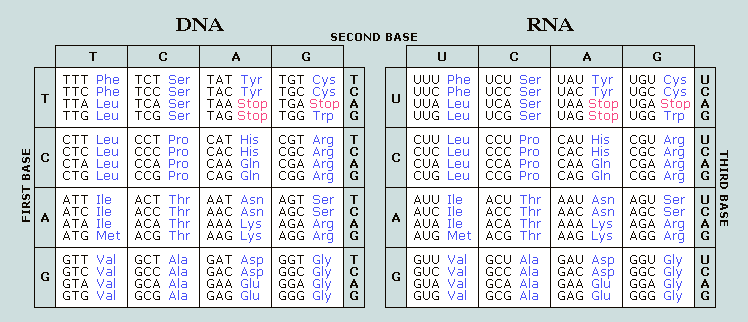Molecule Tutorials - Herong's Tutorial Examples - v1.26, by Herong Yang
DNA Coding and Codons
This section provides a quick introduction of the DNA coding, the 'language of life', which uses combinations of 3 different nucleotides as codons to store instructions in genes to build proteins.
What Is DNA Coding? - DNA Coding is really the “language of life". As living things evolve in the nature, the DNA coding language is developed to store instructions in genes which are segments of double helix DNA structures in chromosomes.
What Is DNA codon? - A DNA codon is a sequence of 3 nucleotides with different combinations of nucleobases: Adenosine (A), Cytidine (C), Guanosine (G), Thymidine (T) and Uridine (U). For example, CGC (Cytidine-Guanosine-Cytidine) is a DNA codon.
The instruction stored in a gene is actually organized as a sequence of DNA codons. For example, the SPRR4 (Small Proline Rich Protein 4) gene, which contains coded instructions to construct the SPRR4 protein. The SPRR4 gene has 240 nucleobases organized as 80 codons as shown below:
ATG-TCT-TCC-CAG-CAG-CAG-CAG-CGG-CAG-CAG-CAG-CAG-TGC-CCA-CCC-CAG-AGG-GCC-CAG- CAG-CAG-CAA-GTG-AAG-CAG-CCT-TGT-CAG-CCA-CCC-CCT-GTT-AAA-TGT-CAA-GAG-ACA-TGT- GCA-CCC-AAA-ACC-AAG-GAT-CCA-TGT-GCT-CCC-CAG-GTC-AAG-AAG-CAA-TGC-CCA-CCG-AAA- GGC-ACC-ATC-ATT-CCA-GCC-CAG-CAG-AAG-TGT-CCC-TCA-GCC-CAG-CAA-GCC-TCC-AAG-AGC- AAA-CAG-AAG-TAA
There are only 64 codons (3 digits of 4 nucleobases, ACGT, gives 43 = 64 combinations) used in genes. Scientists have discovered that each unique codon represents one specific instruction in the process of building proteins like "starting" to build a new protein, "adding" a specific amino acid to the new protein, or "stopping" build the new protein.
When a gene is transcribed to a RNA sequence, the same coded instruction is copied to RNA codons (3 digits of 4 nucleobases, ACGU). So we have actually two identical genetic codon charts, DNA codon chart and RNA codon chart, with Thymidine (T) and Uridine (U) acting as equivalent nucleobases.
The picture (whatabeginning.com) below show DNA and RNA codon charts with protein building instructions. The 3-letter amino acid name next to each codon presents the instruction of "adding" the named amino acid to protein.

Note the ATG (DNA codon) and the AUG (RNA codon) represent the "adding" amino acid Methionine (Met) instruction. But they also represent the "staring" a new protein instruction for most genes.
With the above codon charts, we can easily predict the amino acid sequence of the resulting protein generated from a gene. For example, the SPRR4 (Small Proline Rich Protein 4) gene listed above will generate proteins with the following amino acid sequence. The "*" at the end represents the end, not an amino acid.
MSSQQQQRQQQQCPPQRAQ QQQVKQPCQPPPVKCQETC APKTKDPCAPQVKKQCPPK GTIIPAQQKCPSAQQASKS KQK*
Table of Contents
Molecule Names and Identifications
Nucleobase, Nucleoside, Nucleotide, DNA and RNA
Gene Expression - Building Proteins
Genetic Transcription - Creating mRNA
Genetic Translation - Creating Protein
DNA Gene Sequence - Exons and Introns
Chromosome Replication (or DNA Replication)
ChEMBL Database - European Molecular Biology Laboratory
PubChem Database - National Library of Medicine
INSDC (International Nucleotide Sequence Database Collaboration)
HGNC (HUGO Gene Nomenclature Committee)